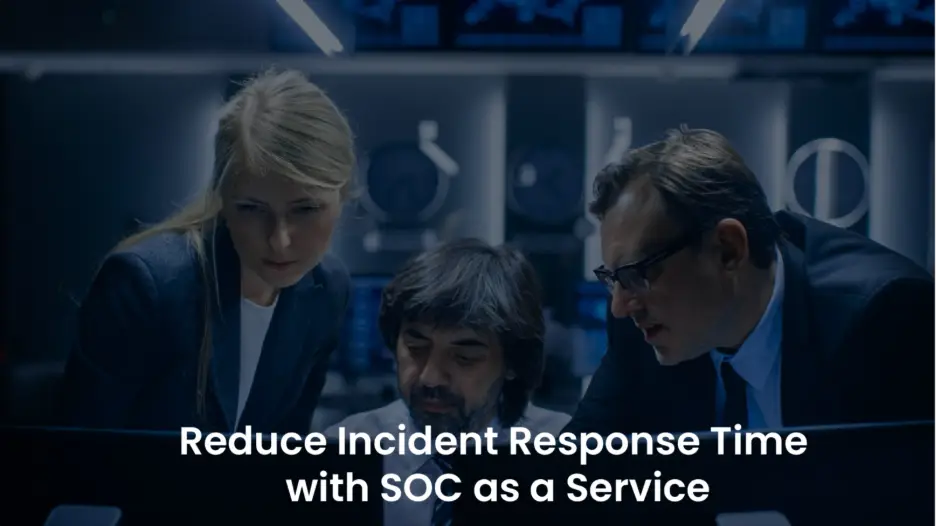
Before delving into SOC as a Service (SOCaaS), it is essential to grasp the concept of a Security Operations Center (SOC), its fundamental functions, capabilities, and the crucial role it plays in protecting an organisation's digital infrastructure. This understanding underscores the significance of SOCaaS.
This article explores how SOC as a Service significantly reduces incident response time by examining its importance, best practices, and key metrics like MTTD (Mean Time to Detect) and MTTR (Mean Time to Respond). It elaborates on how SOCs maintain continuous monitoring, employ automated triage, and manage responses across cloud and endpoint environments. Furthermore, it explains how the integration of SOCaaS with existing security stacks enhances visibility and fortifies cybersecurity resilience. Readers will acquire insights into how SOC strategy, drills, and threat intelligence contribute to faster containment, alongside the benefits of utilising managed SOC services to access expert analysts, cutting-edge tools, and scalable processes without the necessity of developing these capabilities internally.
Effective Strategies for Minimising Incident Response Time with SOC as a Service
To effectively minimise incident response time using SOC as a Service (SOCaaS), organisations must align technology, processes, and expert knowledge to quickly identify and contain potential threats before they escalate into serious issues. A dependable managed SOC provider integrates continuous monitoring, advanced automation, and a skilled security team to enhance each stage of the incident response lifecycle. This holistic approach ensures that organisations remain one step ahead of cyber threats, maintaining the integrity of their systems.
A Security Operations Center (SOC) operates as the central command hub for an organisation's cybersecurity framework. When delivered as a managed service, SOCaaS incorporates essential elements such as threat detection, threat intelligence, and incident management into a cohesive framework, enabling organisations to respond to security incidents in real-time effectively. This integration is pivotal for ensuring that security incidents are addressed promptly and efficiently, ultimately protecting the organisation's assets and data.
The most effective methods for reducing response time include:
- Continuous Monitoring and Detection: By utilising advanced security tools and SIEM (Security Information and Event Management) platforms, organisations can meticulously analyse logs and correlate security events across various endpoints, networks, and cloud services. This real-time monitoring provides a comprehensive perspective of emerging threats, significantly reducing detection times and aiding in the prevention of potential breaches. The timely identification of these threats is critical for maintaining a robust security posture.
- Automation and Machine Learning: SOCaaS platforms leverage the capabilities of machine learning to automate routine triage tasks, prioritise critical alerts, and initiate predefined containment strategies. This automation not only reduces the time security analysts dedicate to manual investigations but also expedites and enhances responses to incidents. As a result, organisations can address threats more swiftly and effectively, ultimately minimising their risk exposure.
- Skilled SOC Team with Defined Roles: A managed response team is composed of experienced SOC analysts, cybersecurity professionals, and incident response specialists who operate with clearly defined roles and responsibilities. This structured approach guarantees that every alert is met with immediate and appropriate attention, thereby enhancing overall incident management. The clarity in roles allows for quicker decision-making and more effective response actions.
- Integrated Threat Intelligence and Proactive Hunting: Proactive threat hunting, supported by global threat intelligence, facilitates the early detection of suspicious activities, thereby minimising the risk of successful exploitation and strengthening incident response capabilities. By continuously analysing threat patterns, organisations can stay ahead of potential threats and improve their defensive measures significantly.
- Unified Security Stack for Enhanced Coordination: SOCaaS consolidates diverse security operations, threat detection, and information security functions under a single provider. This integration enhances coordination among security operations centres, resulting in quicker response times and a reduced time to resolution for incidents. The synergy achieved through this unified approach is vital for maintaining a proactive security environment.
Why is SOC as a Service Essential for Minimising Incident Response Time?
Here’s why SOCaaS is indispensable:
- Continuous Visibility: SOC as a Service offers real-time visibility across endpoints, networks, and cloud infrastructures, enabling the early identification of vulnerabilities and unusual behaviours before they escalate into significant security breaches. This level of visibility is paramount for any organisation striving to maintain a secure environment.
- 24/7 Monitoring and Swift Response: Managed SOC operations function continuously, meticulously analysing security alerts and events. This constant vigilance ensures rapid incident responses and swift containment of cyber threats, significantly enhancing the overall security posture. The round-the-clock monitoring is essential for identifying and mitigating threats before they can cause substantial damage.
- Access to Expert Security Teams: Partnering with a managed service provider grants organisations access to highly trained security experts and incident response teams. These professionals can effectively assess, prioritise, and respond to incidents promptly, eliminating the financial burden of maintaining an in-house SOC. The expertise they bring is invaluable in navigating the complexities of modern cyber threats.
- Automation and Integrated Security Solutions: SOCaaS integrates advanced security solutions, analytics, and automated response playbooks to streamline incident response strategies, significantly reducing delays caused by human intervention in threat analysis and remediation. The efficiency gained through automation is essential for maintaining agile and responsive security operations.
- Enhanced Threat Intelligence Capabilities: Managed SOC providers utilise global threat intelligence to proactively anticipate emerging risks within the evolving threat landscape, thereby strengthening an organisation's defences against potential cyber threats. This proactive stance is vital for staying ahead of malicious actors.
- Improved Overall Security Posture: By combining automation with expert analysts and scalable infrastructure, SOCaaS empowers organisations to sustain a resilient security posture, effectively meeting contemporary security demands without overloading internal resources. This approach ensures that organisations can respond effectively to the dynamic threat environment.
- Strategic Alignment for Enhanced Focus: SOC as a Service allows organisations to focus on strategic security initiatives while the third-party provider manages daily monitoring, detection, and threat response activities, effectively reducing the mean time to detect and resolve incidents. This strategic alignment is crucial for enhancing an organisation's overall security capabilities.
- Real-Time Management of Security Incidents: Integrated SOC monitoring and analytics provide a comprehensive overview of security events, enabling managed security services to identify, respond to, and recover from potential security incidents with remarkable efficiency. This real-time management is essential for minimising the impact of incidents on business operations.
What Proven Best Practices Improve Incident Response Time with SOCaaS?
Here are the most effective best practices:
- Establish a Comprehensive SOC Strategy: Clearly define structured processes for detection, escalation, and remediation. A well-articulated SOC strategy ensures that each phase of the incident response process is executed efficiently across various teams, thereby enhancing overall effectiveness. This clarity of strategy is vital for ensuring that all team members are aligned and working towards common goals.
- Implement Continuous Security Monitoring: Ensure 24/7 security monitoring across all networks, endpoints, and cloud environments. This proactive approach facilitates the early detection of anomalies, significantly reducing the time required to identify and contain potential threats before they escalate. Consistent monitoring is crucial for maintaining an effective security posture.
- Automate Incident Response Workflows for Efficiency: Integrate automation within SOC solutions to expedite triage, analysis, and remediation processes. Automation minimises the need for manual intervention while enhancing the overall quality of response operations. This efficiency is essential for addressing threats quickly and effectively.
- Leverage Managed Cybersecurity Services for Scalability: Partnering with specialised cybersecurity service providers allows organisations to seamlessly scale their services while ensuring expert-led threat detection and mitigation without the operational challenges of maintaining an in-house SOC. This scalability is crucial for adapting to the dynamic nature of cyber threats.
- Conduct Regular Threat Simulations for Preparedness: Execute simulated attacks, such as DDoS (Distributed Denial of Service) drills, to assess an organisation's security readiness. These simulations help identify operational gaps and refine the incident response process to bolster overall resilience. Regular practice ensures that teams are prepared to respond effectively to real-world threats.
- Enhance Data Security and Visibility Across Systems: SOCaaS platforms consolidate telemetry from multiple systems, providing unified visibility into network, application, and data security layers. This comprehensive perspective significantly shortens the time between detection and containment of threats. Enhanced visibility is critical for effective incident management.
- Integrate SOC with Existing Security Tools for Cohesion: Align current security tools and platforms within the managed SOC ecosystem to dismantle silos and improve overall security outcomes, fostering a more collaborative security environment. This integration enhances the efficiency of security operations.
- Adopt Solutions Compliant with Industry Standards: Collaborate with reputable vendors, such as Palo Alto Networks, to integrate standardised security solutions and frameworks that enhance interoperability while reducing the occurrence of false positives. Compliance with industry standards is vital for maintaining effective security measures.
- Measure and Optimise Incident Response Performance Continuously: Regularly monitor key metrics, including mean time to detect (MTTD) and mean time to respond (MTTR), to identify opportunities for reducing delays in response cycles and enhancing the maturity of SOC operations. Continuous improvement is essential for adapting to evolving threats.
The Article Reduce Incident Response Time with SOC as a Service Was Found On https://limitsofstrategy.com

